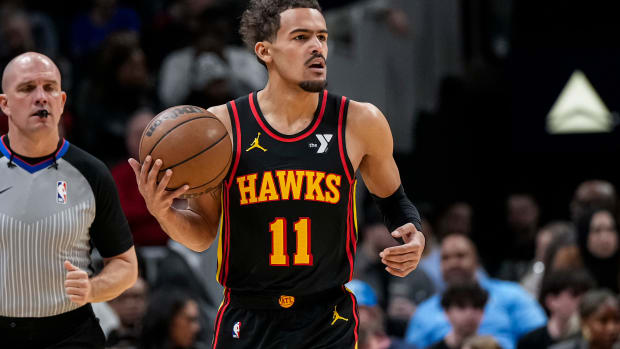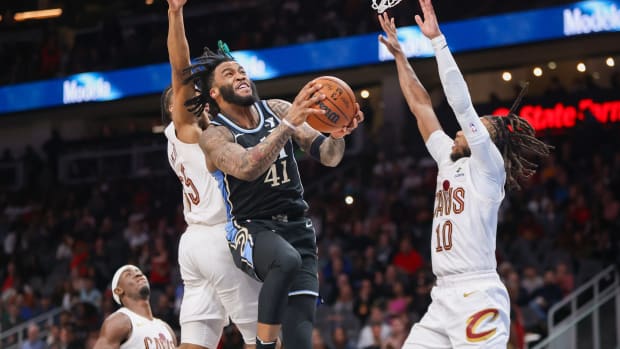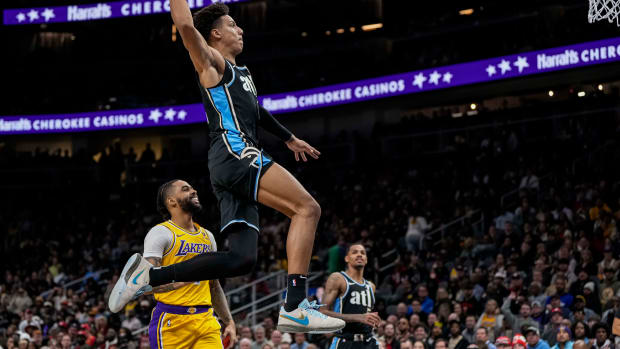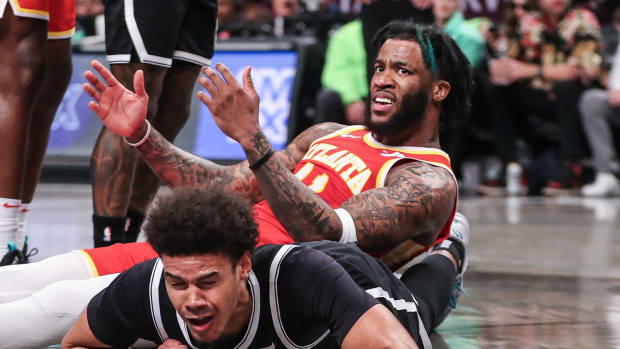Observations From the Hawks' Disappointing Road Trip
The NBA schedule doesn’t relent. If that wasn’t clear to the young Hawks before their five-game trip that sent them through Portland, Denver, Phoenix, and Los Angeles, it ought to be now and certainly will be Wednesday night when Giannis Antetokounmpo and the Milwaukee Bucks visit. Shorthanded or not, Atlanta must press on.
The last two weeks tested the Hawks in a way nothing but a long road trip against quality teams can, and revealed a good deal about the team’s current state of affairs. We learned how vital John Collins is, and how difficult it is to replace him. On some nights, simply having Trae Young is enough; on others, Atlanta’s lack of secondary playmakers leaves it fatally vulnerable. In L.A., the Hawks experienced how lethal the combination of elite talent and reliable depth can be.
Here’s what else stood out from the team’s journey west:
What has gotten into Damian Jones?
Jones entered the season a castoff – mere flotsam in a trade that sent Omari Spellman to Golden State. His play over the first nine games of the year was uninspiring at best, damaging at worst. But when the Hawks hit the road, something clicked for Jones, who has become Lloyd Pierce’s center of preference.
For players like Jones, whose standing in the rotation can shift by the week, staying engaged and ready can be a challenge unto itself – not to mention the difficulty of earning and keeping a coach’s trust. Jones maintained an even approach, even when Atlanta’s center rotation was at its most volatile, and is now reaping the rewards of his patience. “Coaches always talk about being professional,” he said. “Just staying focused, don’t let your mind wander while you’re on the bench, and just get to it.”
Being the best center in the Hawks’ rotation is no great accomplishment, but Jones deserves credit for making the improvements necessary to earn the title. As Alex Len and Bruno Fernando struggled to provide offense, Jones found a niche as a rim-runner and pick-and-roll finisher. He helps approximate some of the roll gravity Atlanta lost with John Collins’ suspension, giving Trae Young a much-needed aerial outlet in the pick-and-roll. His hands seem to have improved overnight, making him a more dangerous finisher around the rim:
"It's definitely good to have [Jones] where he is a threat at the rim," Young said. "Bigs have to really pick and choose when they're going to stop me and when they're going to stop the roller. So it's good to have a guy like that to set hard screens and also get behind the defense and catch lobs."
Jones has benefitted tremendously from playing with Young, who bends defenses with his shooting ability and thus opens the lane for others. “It’s kind of similar to Steph [Curry],” Jones said. “Trae shoots it really well. And having him space the floor is great. Guys will be attracted to him and he has a good eye. He finds guys, he finds me on the roll for lobs.” Jones has even flashed passing vision out of those rolls when opponents trap Young high on the floor:
“We did that with Golden State,” Jones said. “We hit the short roll, then we hit the dunker spot or we hit the opposite corner… A lot of times I’m finishing, but other times you just catch it and make a play out of it.”
Defensively, Jones remains a beat behind most of the time. He’ll fly in to erase a layup every now and then, but his relatively slow reaction time leaves him a step slow on many rotations. He remains ineffective switching onto the perimeter and struggles to contain quicker point guards in the pick-and-roll. But even those weaknesses have smoothed out around the edges. He's less frantic lurching at ball-handlers and chasing blocks, instead staying in position according to the defensive scheme.
More importantly than any overwhelmingly positive play, Jones has simply eliminated a lot of the damaging play that plagued his minutes early in the year. He hasn’t suddenly made himself into some dominant force, but simply being a net neutral represents a massive improvement.
The importance of De’Andre Hunter’s rebounding
In a piece on The Ringer this week, the great Rob Mahoney explored, through the lens of Luka Dončić, how rebounding wings could be the NBA’s next great market inefficiency . Dončić is playing like an MVP candidate offensively, but his work on the glass gives Dallas the flexibility to play him in different varieties of lineups without regard for positional designations. That allows the Mavericks to put faster, more skilled units on the floor. Mahoney highlights forwards like Kawhi Leonard, Justise Winslow, and Jaylen Brown, all of whom hit the boards with regularity and have spent significant time playing bigger positions in smaller lineups.
De’Andre Hunter could fall into that group in time, which would be a significant development for Atlanta’s frontcourt. Though the rookie currently grades out as a below-average rebounder by the numbers, it’s the quality of his boards that has been encouraging through 13 games. He has no issue going against bigger, more experienced players for contested rebounds:
Though the two have been compared for their stoic demeanors and strong, lanky body types, Hunter is not Leonard. But there are faint Kawhian shades in the way Hunter rebounds – even if he doesn’t do it as effectively as the Board Man did in his rookie season.
He’ll need to translate those flashes into more consistent production – the Hawks are far worse on the defensive glass with Hunter on the floor – but if he rounds into an above-average rebounder, it makes playing small a more viable option. In an ideal world, Atlanta would spend significant minutes with Collins at center and Hunter at power forward in supercharged offensive lineups. But that look only works if the Hawks can survive on the other end of the floor, and rebounding is a critical – if often overlooked – component of an effective defense.
Dončić, Leonard, and so many others are proof that playing small doesn’t necessarily mean sacrificing rebounds; teams just need the sort of player who can help them maintain an edge. It’s unclear if Hunter will become dominant enough on the glass to follow in that lineage, but there’s a world of possibility to be found if he does.
The power forward rotation remains unstable
Prior to the season, Atlanta could not have prepared for a situation in which its starting and third-string power forwards were unavailable for the same five-game stretch, but so it was as the team toured the West Coast without John Collins (currently serving a 25-game suspension) or Vince Carter (who stayed in Atlanta for the birth of his daughter). Pierce was creative in filling their minutes, but the Hawks understandably looked a bit out of sorts when Jabari Parker sat.
First, Pierce tried pulling Hunter early in the first quarter so as to put him back in at power forward with the second unit, then used the same approach with Parker so as to keep Hunter on the wing. Eventually, he settled on Fernando as the backup four, most often in lineups featuring Len at center. This is an imperfect solution to a significant problem, but Pierce doesn’t have many options as his disposal. Evan Turner, who served as the Hawks’ primary ball-handler in L.A. when Young rested, could see more time as the nominal power forward when Parker rests – though Pierce must be careful about how much he and DeAndre’ Bembry overlap. Chandler Parsons played two minutes and nine seconds at the four against the Lakers.
Collins’ suspension and Kevin Huerter’s injury (and, to some degree, Carter’s absence, though it’s hard to blame him for missing the trip) could hardly have come at a worse time. Atlanta is in the midst of perhaps its most grueling portion of the schedule, and can’t afford to put itself at any further disadvantage.





